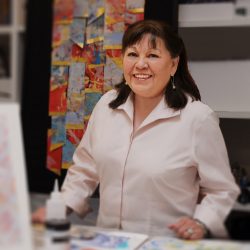Two artists with concurrent solo exhibitions at Eight Modern, though wildly different in their respective approaches to art making, prove to be an uncanny and appetizing fit.
Ramona Sakiestewa, the revered Hopi artist who has long made contemporary work, is celebrated alongside Ming Fay, whose trashy, alternate-reality constructions respond and reverberate so as to elevate both bodies of work to a lovely and strange discourse.
Imagine a tea party with Alice that turns into My Dinner with Andre, but the Wallace Shawn character is obsessed with color. If that doesn’t make any sense, just keep in mind that making sense of art is overrated.
Ming Fay—it will surprise no one who sees the exhibition—spent a great deal of his youth in a wax museum, where his mother worked. His works are rubbery, monstrous and alien. Many of them look like wax figures that have been melted down into strange balls and, like a corn dog, put on a stick. But these sticks are branches crafted from wire, foam and papier-mâché.
On more considered inspection, the sculptural forms and additions that Fay pries out of such standard forms and crafty materials become exotic fruits, unlikely creatures and generally bizarre but inspired specimens. As a sculptor, he sees his responsibility as one of fostering a sense of adventure and folksy mystery, and envisions art-making forays like jungle expeditions in search of undiscovered life.
Pinned to the wall, hanging from the ceiling and recessed into skylights, nooks and low corners, Fay’s constructions succeed in evoking such sentiments in many ways.
Titles and descriptions offer implications of the artist’s intentions and original inspirations, but the experience of them is just as rewarding by imagining oneself to be in a room full of dragonflies or algae or anything or that comes to mind. The constructions tend to be spindly at the top with bulbous polyps forming toward the base, like inverted, grotesque lollipops.
The forms draw more from botany than from body and are exemplary of so much of contemporary art’s withdrawal from object and formalism, and movement toward more spirited and emotive works. Despite the exaltation of craft evident in the materials and the almost haphazard exuberance of many of the works, a formalized practice is apparent. The blending and placement of color and the balance of elements, whether occasioned by intuition or careful consideration, are elegant and perfect. Many pieces read like large gestural still lifes, part real, part referential and part imagined.
Though satisfying as lone works, it is when installed together in laboratory form that Fay’s efforts become a constellation-like barrage of wonder. The otherworldly, deep space sensation is reinforced when a line of the pieces are placed in one, sparse room directly across from three recent works by Ramona Sakiestewa.
Known for bright tapestries, pinpointed with brilliant focal points of color and detail, Sakiestewa demonstrates a far-ranging mastery of color with her Nebula series.
The series portrays swirls and spots of color akin to imagery from the Hubble Space Telescope or middle distance aerial photography that tends toward abstraction. Not only are Sakiestewa’s choices of color and juxtaposition of hue remarkable, but her blending of colors and capacity for shading follow a bold O’Keeffian shadow, encouraging the eye to finish what the materials cannot do alone. These distilled works, like images from deep space or Mark Rothko paintings, contain vast rumblings of energy with a sliver of quiet, a momentary calm.
Staring back across the room at Fay’s work, Sakiestewa’s nebulae echo and sound across the room, whale calls of composition and captured momentum.
The artists could hardly be more different in materials and approach, but that diversity makes for a much improved conversation.

